Post-Mauryan Period - UPSC PDF Download
Political History of North India
- The fragmentation of the Mauryan empire led to the emergence of numerous regional kingdoms across India. Concurrently, invasions from Central Asia and western China occurred, involving groups such as the Indo-Greeks, Scythians (or Shakas), Parthians (or Pahlavas), and Kushanas. These events facilitated closer political and cultural connections between India and Central Asia.
(i) The Shungas
- The last Mauryan king was assassinated by his Commander-in-Chief, Pushyamitra Shunga, who subsequently founded the Shunga dynasty in northern India. During this time, the Indo-Greeks, also referred to as Yavanas, gained independence in Bactria (modern-day Balkh) and began expanding their rule into northwestern and northern India. It is believed that Pushyamitra Shunga clashed with Demetrius, a Bactrian Greek ruler, but without significant political consequences.
- A pillar inscription at Besnagar (now Vidisha) mentions a man named Heliodorus, a native of Taxila near present-day Rawalpindi in Pakistan. He served as an envoy for the Indo-Greek ruler Antialkidas in the court of Bhagabhadra, who is thought to be one of the later Shunga rulers. The inscription states that Heliodorus was a devotee of Lord Krishna.
- In the early first century BC, the final Shunga ruler was treacherously murdered by his minister Vasudeva, who subsequently established the Kanva dynasty. However, little is known about the Kanvas, as only brief references to them exist in later texts.
(ii) The Bactrians or the Indo-Greeks
- The Bactrian-Greeks, also known as the Indo-Greeks, were a group of Hellenistic (Greek) settlers who established themselves in the northwestern regions of India following the death of Alexander the Great in 323 BC. Bactria, which is now part of modern-day northern Afghanistan, became a significant center for these settlers. The rulers of this region were referred to as Bactrian-Greeks due to their Greek heritage. One such ruler, Demetrius, came into conflict with Pushyamitra.
- Among the most notable Indo-Greek rulers was Menander, whose empire is believed to have spanned across southern Afghanistan and Gandhara, a region located west of the Indus River. Menander has been identified as King Milinda, who is mentioned in the renowned Buddhist text Milindapanho. This text describes a series of philosophical questions that Milinda posed to Nagasena, the Buddhist author of the text. As a result of the enlightening answers he received, King Milinda ultimately converted to Buddhism. Menander is thought to have ruled between approximately 155 BC and 130 BC.
(iii) The Shakas
- The Shaka people, also known as Scythians, were originally from Central Asia. They were defeated by their neighbors, the Yueh-chis, who were part of the tribal group that later formed the Kushanas. Gradually, the Shakas migrated to northwestern India, settling around Taxila in the first century BC. Over time, their territories expanded under various Shaka rulers, eventually reaching up to Mathura and Gujarat.
- Rudradaman, the most renowned Shaka ruler, governed in the middle of the second century AD. His empire encompassed nearly the entire western region of India. Rudradaman's accomplishments are documented in a unique inscription carved onto a boulder at Girnar or Junagarh. This inscription is notable for being the first royal inscription of early India composed in classical Sanskrit.
(iv) The Parthians
- The Parthians were an Iranian group with a strong cultural connection to the Shakas, leading them to be referred to as Shaka-Pahlava in Indian sources.
- Evidence of Parthian rule in the northwestern region of present-day Pakistan can be found in the significant Takht-i-Bahi inscription, which was discovered near Peshawar in Mardan. This inscription, dating back to 45 AD, identifies Gondophernes or Gondophares as a Parthian ruler.
- Some historical records suggest that St. Thomas converted both Gondophernes and his brother to Christianity.
The Kushanas
- The Kushanas, who originally hailed from western China, were also known as Yueh-chis. They established a vast empire in Pakistan after defeating the Shakas and Pahlavas. The first notable ruler of the Kushana dynasty was Kujula Kadphises, who was succeeded by his son Wema Kadphises. The most famous of the Kushanas was Kanishka, who is believed to have ascended the throne in AD 78 and initiated the Shaka era. Under Kanishka's rule, the Kushana empire expanded to its greatest extent, stretching from Central Asia to northern India and incorporating regions like Varanasi, Kaushambi, and Sravasti in Uttar Pradesh. Kanishka's rule was significant in that it united central Asia and northern India into a single empire, leading to the blending of various cultures and an increase in interregional trade.
- Kanishka is also renowned for his patronage of Buddhism. He organized the fourth Buddhist Council at Kundalavana (now known as Harwan, near Srinagar in Jammu and Kashmir), which was attended by numerous Buddhist scholars. This council led to the division of Buddhism into two schools: Hinayana and Mahayana. Kanishka also supported the Gandhara and Mathura schools of sculptural art. In his capital city of Purushpura (now Peshawar), he constructed a massive stupa to house the relics of Buddha. This structure was still standing and impressively preserved when the Chinese pilgrim Fa-hsien visited the area in the early 5th century AD. However, the Kushana dynasty's power began to wane from the early 3rd century AD.
(i) Kushana Polity and Administration
- Nothing much is known about the administrative machinery of the Kushanas. Perhaps the whole empire was divided into provinces, each ruled by a mahakshatrapa ( a military governor), who was assisted by a kshatrapa; but how many provinces were there in the empire, is not known. Sources indicate that Kushana horsemen wore trousers while riding. A headless statue of Kanishka found at Mathura reflects the same. A prominent feature of Kushana polity was the title of devaputra, i.e., son of God, used by the Kushana kings. It indicates the claim to divinity by the Kushana kings.
(ii) Contribution of the Kushanas
- The Kushanas occupy a special place in the ancient Indian history because of their contribution to various aspects of life. Their vast empire helped in the growth of internal and external trade. It resulted in the rise of new urban centres. The rich state of economy under the Kushanas is also evidenced by the large number of gold and copper coins that they struck.
- Even in literature and medicine, India made progress. Charaka, known as father of Ayurveda, wrote a book on medicine called Charaksamhita whereas Asvaghosha, a Buddhist scholar, wrote Buddhacharita, a full length biography of the Buddha. Both these scholars were believed to be the contemporaries of king Kanishka. The Kushanas patronized the Gandhara and the Mathura schools of sculptural art which are known for producing the earliest images of Buddha and Buddhisattavas.
Contacts With Central Asia
- Contacts with Central Asia, particularly through the invasions of the Bactrian Greeks and Saka-Pahilavas, had a significant impact on India's political, cultural, and social landscape. As these foreign groups invaded India, they gradually lost their distinct identities and were assimilated into the local Brahmanical society, often adopting the status of lower-grade Kshatriyas. Many of these foreign invaders also embraced Buddhism, such as the Indo-Bactrian ruler Menander, who was converted by a monk named Nagasena.
- The cultural exchange between India and Central Asia led to the introduction of new techniques in coin-making. Previously, Indians used crude punch-marked coins, but the influence of the central Asians, particularly the Greeks, led to the adoption of more refined Greek-style coins. These coins featured legends and the bust of the ruler, setting the standard for future Indian coinage. Additionally, Indian astronomers gained valuable knowledge from their Greek counterparts, who were referred to as "yavanacharya" in early Indian literary works. This exchange of knowledge included learning how to create horoscopes.
- The contacts with Central Asia also led to a significant development in Indian art, particularly in the field of sculpture. The Gandhara school of Buddhist sculpture emerged as a result of the fusion of Indian and Greek artistic styles. This new wave of artistic expression demonstrated the substantial cultural intermingling between India and Central Asia during that period.
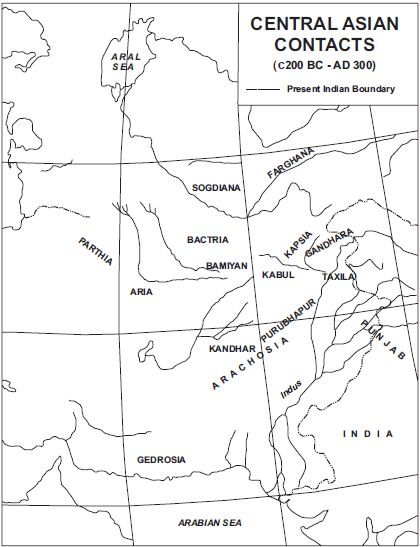 Central Asian Contacts
Central Asian Contacts
Emergence of Early States in Orissa and the Deccan
- We know that the Deccan as well as eastern India were parts of Ashoka’s empire. He had conquered Kalinga through a violent battle in which loss of men and property was enormous. It was as a result of the Mauryan rule in these regions that after its decline we notice the emergence of kingdoms in Kalinga and the Deccan for the first time in the Indian history.
Kalinga
- Kalinga, which is now known as Orissa, rose to prominence under the rule of the Chedi dynasty's kings after Ashoka. Unfortunately, there is limited information about these rulers, with the exception of King Kharavela. His accomplishments are documented in an inscription called the Hathigumpha inscription, which is located in the Udayagiri hills near Bhuvaneshvar in Orissa.
- The inscription is named after a carved stone elephant situated next to the boulder carrying the inscription. According to the inscription, Kharavela was a follower of Jainism and had numerous successful battles against neighboring kingdoms. He is believed to have lived in the first century BC.
The Satavahanas
- The Satavahanas emerged as a significant political power in India around the middle of the first century BC. The most prominent ruler among them, Gautamiputra Satakarni, ruled during the first century AD and is known for expanding the Satavahana territories by defeating Nahapana, a Shaka ruler in Western India.
- As a result, his kingdom stretched from the Krishna River in the south to the Godavari River in the north. The Satavahanas established their capital at Pratishthana (present-day Paithan), located near Aurangabad in Maharashtra. However, the Satavahana kingdom eventually declined and was eradicated by the early third century AD, after which the Ikshvaku dynasty took over the region.
Satavahana Polity and Adminstration
- Satavahana kingdom was divided into subdivisions called aharas or rashtras, meaning districts. The lowest level of administration was a grama which was under the charge of a Gramika. There were also officers called amatyas who were perhaps ministers or advisors of the king. Revenue was collected both in cash and kind. Satavahanas kings were the first in Indian history to make tax free land grants to Buddhists and Brahmanas to gain religious merit. This practice became more prominent in succeeding periods. The Satavahana kings claimed to be Brahmanas and considered it their primary duty to uphold varna system i.e. the four fold division of social structure.
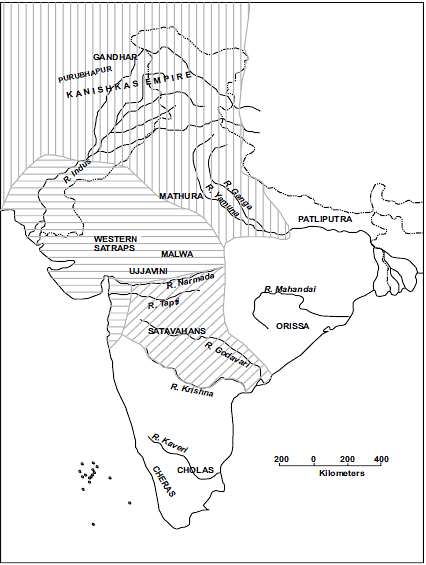
Trade and Commercial Activities
(i) Internal and External Trade Routes
- The growth of trade and commerce, both internally and externally, was a significant feature of the post-Mauryan period in ancient India. There were two major internal land routes during this time. The first, known as Uttarapatha, connected the northern and eastern parts of India with the northwestern regions, which would be present-day Pakistan and further beyond. The second, called Dakshinapatha, linked the peninsular India with the western and northern parts of the country.
- The Dakshinapatha was the primary route connecting north and south India. It originated from Kaushambi, near Allahabad, and passed through Ujjaiyini (modern Ujjain) before extending up to Bhrigukaccha or Broach, which was an important port on the western coast. The Dakshinapatha also connected with Pratishthana (modern Paithan), the capital of the Satavahanas.
- In terms of external trade routes, the discovery of monsoons by the Greek navigator Hippatus in 45 AD led to an increase in sea voyages for trade purposes. Important Indian ports on the western coast included Bharukachchha, Sopara, Kalyana, and Muziris, among others. Ships from these ports sailed to the Roman Empire through the Red Sea.
- Trade with Southeast Asia was conducted via sea routes. Notable ports on the eastern coast of India were Tamralipti (located in West Bengal) and Arikamedu (on the Tamil Nadu Coast). Sea trade between Bharukachchha and the ports of Southeast Asia also took place during this period.
(ii) Trade with West and Central Asia
- Trade between India and the West, particularly with the Roman Empire, was a significant aspect of commercial activities during the post-Mauryan period. Initially, this trade was conducted through land routes. However, due to frequent disruptions caused by the Persians who ruled the regions these routes passed through, the focus shifted to maritime routes. As a result, ships could now travel directly from Indian ports to those on the Red Sea and the Persian Gulf.
- A comprehensive account of the Indo-Roman trade can be found in the first-century AD book, Periplus of the Erythrean Sea, written by an anonymous author. The primary goods sought by the Romans were Indian products such as spices, perfumes, jewels, ivory, and fine textiles like muslin. Among the spices exported from India to the Roman Empire was pepper, which was often referred to as yavanapriya, possibly due to its popularity among the Romans. The spice trade with the Roman Empire was predominantly based in southern India.
- In addition to spices, the Romans imported various precious and semi-precious stones like diamonds, carnelians, turquoise, agates, and sapphires, as well as pearls, indigo, sandalwood, and steel. In exchange for these imports, the Romans exported gold and silver to India. This is evidenced by the numerous Roman coins from the first century AD discovered in the Indian subcontinent, indicating a significant flow of gold from the Roman Empire to India.
- Other important items exported from the Roman Empire included wine, as suggested by the wine amphorae and sherds of Roman ware found in considerable quantities at Arikamedu in southern India. Additionally, Western traders brought tin, lead, coral, and slave girls to India. Overall, the trade between India and the West, particularly the Roman Empire, was a vital component of the commercial landscape during the post-Mauryan period.
(iii) Crafts and Industries
- Crafts production started growing in this period with tremendous impetus, as trade and commerce, both internal and foreign, was dependent to a great extent on the craft activities. The text called Milindapanho mentions 75 occupations of which 60 were associated with crafts. The level of specialization was very high and there were separate artisans working in gold, silver, precious stones etc. Ujjain was a prominent bead making centre.
- Textile industry was another prominent industry. Mathura and Vanga (east Bengal) were famous for variety of cotton and silk textiles. The discovery of some dying vats at some sites in south India indicates that dying was a thriving craft in the area during this period. The artisans in this period touched new heights of prosperity and there are numerous inscriptions which refer to the donations made by artisans to monasteries.
(iv) Guilds
- Merchant communities in ancient times were organized into groups known as Shreni or guilds, which were led by a person called the Sreshthi. These guilds were comprised of individuals involved in the same profession or dealing with the same goods. Another type of mercantile group was known as Sartha, which represented a mobile trading corporation or caravan of interregional traders. The leader of a Sartha guild was called a Sarthavaha.
- Various craft vocations were also organized into guilds, each led by a headman called Jyestha. These vocations included weavers, corn dealers, bamboo workers, oil manufacturers, potters, and others. The main purpose of these guilds was to bring together merchants and craftsmen who shared the same profession or traded in the same commodity. Members of these guilds elected their leader and established their own rules and regulations concerning prices, quality, and other aspects of their business, ensuring that they operated in a fair and mutually beneficial manner.
- In addition to their primary function, guilds also served as financial institutions, accepting deposits from the public and offering a fixed rate of interest on those deposits. This allowed them to provide financial support to their members and contribute to the overall economic stability of their community.
Art and Architecture
- Art in the post-Mauryan period was predominantly religious. Two most important features concerning art and architecture of this period are the construction of stupas and development of regional schools of sculpture.
- Idols of the Buddha were carved out for the first time in this period. On account of contact with the foreigners from northwest, a specific school of art called Gandhara School of art developed in this period. It was influenced, to a great extent, by the Greek style or art forms.
(i) Stupas
- Stupas are large, dome-shaped structures with a central chamber that houses relics of Buddha or Buddhist monks in a small casket. They have a pathway around the base for clockwise circumambulation (pradakshina) and are enclosed by railings, initially made of wood and later of stone. Three notable stupas from this period can be found at Bharhut and Sanchi in Madhya Pradesh, both originally constructed by Emperor Ashoka and later expanded, and at Amravati and Nagarjunkonda in Andhra Pradesh.
- The Bharhut stupa, dating back to the mid-second century BC, is known for its sculptures and red stone railings. At Sanchi, three prominent stupas were built during this time, with the largest one, initially erected by Ashoka, being expanded to twice its size in the second century BC. Although several stupas were constructed in southern India, none have survived entirely. The Amravati stupa, located in Andhra Pradesh, assumed its final form in the second century AD. The sculptures adorning these stupas often depict themes from Jataka and other Buddhist tales.
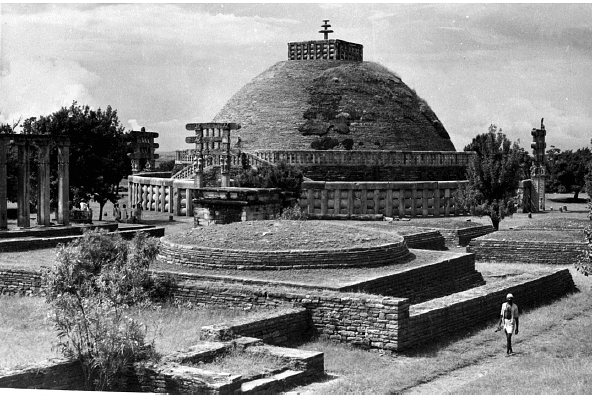 Sanchi Stupa
Sanchi Stupa
(ii) Rock Cut Architecture
- Apart from the stupas, this period also marks a progress in rock cut architecture. A large number of temples, halls and places of residence for monks were cut out of the solid rocks near Pune and Nasik in Maharashtra under the Satavahanas. The place of worship generally had a shrine cell with a votive stupa placed in the centre. This place was known as a chaitya and the rock cut structure used as the residence for monks was called a vihara.
(iii) Schools of Sculptural Art
- In the first century, Buddhism split into two branches: Hinayana and Mahayana. Mahayana Buddhism promoted the worship of Buddha as a god in human form, leading to the creation of numerous Buddha images in various regions. During this time, three major sculptural art schools emerged: the Mathura school of art, the Gandhara school of art, and the Amravati school of art.
- The Mathura School of Art is particularly known for its significant contribution to the development of Buddha images, possibly being the first to carve these representations. Artists from this school used a locally sourced red stone with black spots to create the sculptures. In addition to Buddhist imagery, the Mathura school also produced a large number of Jain sculptures and ayagapatas, which are stone slabs used for placing objects of worship. The influence of Brahmanical traditions on the Mathura school is evident, as numerous sculptures of Brahmanical deities such as Kartikeya, Vishnu, and Kubera were created during the Kushana period.
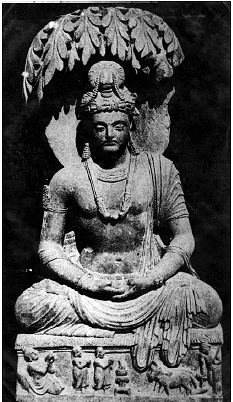 Gandhara Art - Bodhisattva
Gandhara Art - Bodhisattva
- The Gandhara School of Art emerged in the Gandhara region, located in the northwestern part of the Indian Subcontinent. This area was ruled by various groups, including the Greeks, Mauryas, Sungas, Shakas, and Kushanas. As a result, the art that developed in this region around the beginning of the Christian era is sometimes referred to as Graeco-Roman, Indo-Greek or Graeco-Buddhist, reflecting the diverse influences in the style. Although the primary theme of Gandhara sculpture is Buddhist, the style incorporates elements of Roman, Greek, and Indian art. The main patrons of this school were the Shakas and Kushanas.
- Gandhara artists primarily used blue-grey schist to create the statues of Buddha and Bodhisattvas. The school's distinctive characteristics include the exquisite portrayal of human figures, showcasing well-defined muscle structures. Buddha is often depicted wearing a garment in the Graeco-Roman style, with curly hair. These stunning Buddha images are considered among the finest sculptures in the world.
- On the other hand, the Amravati School of Art thrived in the Andhra Pradesh region between the lower valleys of the Krishna and Godavari rivers. The primary patrons of this art form were the Satavahans, followed by their successors, the Ikshavaku rulers. This school of art is believed to have flourished between 150 BC and 350 AD. Amravati sculptures are commonly found on railings, plinths, and other parts of stupas, and the themes often depict stories from the life of the Buddha.
- A key characteristic of Amravati art is its narrative style, with medallions carved in such a way as to naturally depict a story. For instance, one medallion shows the tale of Buddha taming an elephant. Another noteworthy feature of Amravati art is the use of white, marble-like stone for carving figures. The emphasis in this school is on human figures, rather than nature.
Early History of South India
1. The Megalithic Cultures of South India
- The Megalithic cultures (1200 BC–300 BC) of South India succeeded the Neolithic phase, which was characterized by the use of polished stone axes and blade tools. Megaliths were tomb sites consisting of burials or graves covered with large stones, typically located outside the settlement area. These burials marked the first discovery of iron objects in South India, and the use of Black and Red ware pottery was a notable feature of the Megalithic people.
- Megaliths have been found in abundance from the Nagpur area in Maharashtra, extending to the southern tip of the Indian Peninsula. Significant sites with Megalith graves include Brahmagiri, Maski (Karnataka), Adichallanur (Tamilnadu), and Junapani near Nagpur (Maharastra). The iron tools found in these graves were consistent across all the Megalithic sites, indicating their craft activities. These tools included arrowheads, daggers, swords, spearheads, tridents, battle axes, hoes, ploughshares, and sickles.
- The presence of these artifacts, along with food grains such as wheat and rice found at various Megalithic sites, suggests that the Megalithic people relied on a combination of agriculture, pastoralism, and hunting for their sustenance. The Megalithic period in South India was followed by the Sangam age.
2. The Sangam Age
- The Sangam Age refers to an early period in the history of South India, during which a significant number of Tamil poems were authored by various poets. The term "Sangam" denotes a gathering or assembly of Tamil poets, and it is believed that three such assemblies took place sequentially. Each of these Sangams occurred at different locations under the patronage of the Pandya kings of Madurai.
- The poems in the Sangam literature focused on two primary themes: love and war. These works were later compiled into eight collections known as Ettutogai, and they are thought to have been created between 300 BC and 300 AD. One of the most notable aspects of the Sangam literature is its detailed depiction of the society and culture of Tamilaham, the Tamil region, during that time. The literature also highlights the peaceful and harmonious interactions between the Tamil region and the northern Aryan culture.
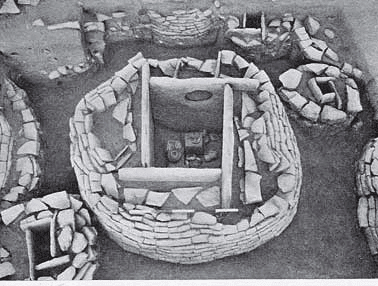
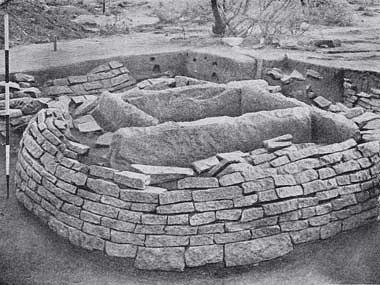 Megalithic Graves
Megalithic Graves
- Tamilaham stretches between the hills of Tirupati and the tip of Kanyakumari. It was divided amongst large number of chieftains and the chieftainship was hereditary. The important chieftains who dominated Tamil region during Sangam Age were the Cholas, with their capital at Uraiyur, the Cheras with their capital at Vanji, (near Karur) and Pandyas with their capital at Madurai.
- The Cholas, Pandyas and Cheras had several subordinate chiefs. Tribute from subordinate chiefs along with plunder, were the main sources of revenue. There was frequent conflicts between the Cheras, Cholas and Pandyas. It gave large scope to the Sangam poets to compose poems on war.
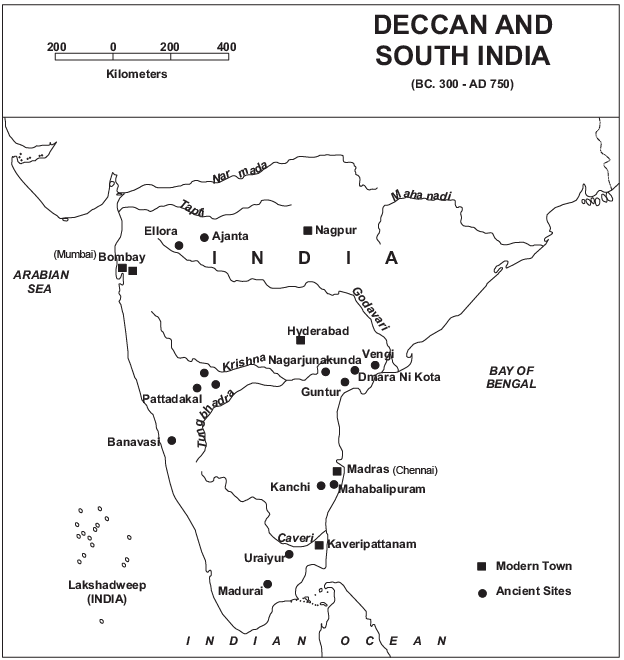 India: Tamilnadu and Northern Culture
India: Tamilnadu and Northern Culture
- During the Sangam period, the Tamilaham region was divided into five eco-zones, or tinais, based on their economic resources. These were kurinji (hilly region), palai (arid zone), mullai (pastoral tracts), marudam (wet lands), and neital (seacoast). These zones were scattered throughout the region and not clearly demarcated. People in each tinai had their own modes of subsistence, based on the available resources in their respective zones.
- Social classes in the Sangam period were not ranked as higher or lower, as was the case in North India. People were known by their occupations, such as artisans, salt merchants, and textile merchants. The rich lived in well-decorated brick houses and wore expensive clothes, while the poor lived in mud huts with few clothes. War heroes held a special place in society, and memorial stones were raised in honor of those who died in battle.
- Women in the Sangam period appear to have been educated, as evidenced by the poems contributed by women poets to the Sangam literature. Women were also involved in various economic activities, such as agriculture, animal husbandry, and crafts. However, the practice of Sati was also present, though not obligatory.
- The economy during the Sangam period was diverse, with people engaged in agriculture, crafts, and trade. Paddy was the most important crop and served as a medium of barter exchange for inland trade. The construction of tanks and dams was encouraged to support agriculture. The Chola king Karikala is credited with constructing the earliest dam in the country on the Kaveri river.
- Crafts, such as spinning and weaving of textiles, were also important, as was salt production. Trade with the Roman world was a significant feature of the Sangam economy, with the discovery of monsoons and the use of direct sea routes between India and the Western world contributing to this growth. This led to the rise of important towns and craft centers in the Tamil region, such as Vanji, Muzris, Madurai, Korkai, Uraiyur, and Kaveripattinam.
- The Sangam period also witnessed close and peaceful interactions between North Indian and South Indian religious traditions. The local people worshipped various gods, and there were also references to the presence of Buddhists and Jainas in the Tamil region. In summary, the Sangam literature provides a glimpse into the political conflict, social inequality, and economic prosperity of the early Tamil region during 300 BC-300 AD.
Conclusion
In conclusion, the political history of North India during the post-Mauryan period was marked by the rise of regional kingdoms, invasions from Central Asia, and cultural exchanges between India and Central Asia. The Shungas, Bactrians, Shakas, Parthians, and Kushanas were the key dynasties that influenced the politics and culture of the region. Meanwhile, in eastern India and the Deccan, the emergence of early states like Kalinga and the Satavahana dynasty laid the foundation for political and economic growth. The growth of trade and commerce, both internally and externally, played a significant role in shaping the socio-economic landscape of the time. Furthermore, advancements in art and architecture, particularly in the construction of stupas and the development of regional schools of sculpture, showcased the rich cultural heritage of the era. The Sangam age in South India also provided valuable insights into the contemporary society and culture through its extensive literary works. Overall, the post-Mauryan period was marked by significant developments in politics, culture, trade, and art that shaped the course of Indian history.Frequently Asked Questions (FAQs) of Post Mauryan Developments
What were the major political changes in North India during the post-Mauryan period?
The post-Mauryan period saw the rise of regional kingdoms such as the Shungas, Bactrians, Shakas, Parthians, and Kushanas. These kingdoms led to closer contact between India and Central Asia, resulting in cultural intermingling and increased trading activities.
How did foreign invasions impact the political history of North India?
Invasions by groups such as the Indo-Greeks, Scythians, Parthians, and Kushanas resulted in the integration of Central Asia with North India as part of a single empire. This led to the blending of different cultures, the development of new coinage systems, and the introduction of new knowledge in areas such as astronomy and horoscope-making.
What were the major trade routes in ancient India, and how did they impact the economy?
The two major internal land routes in ancient India were the Uttarapatha, connecting the northern and eastern parts of India with the northwestern fringes, and the Dakshinapatha, connecting peninsular India with the western and northern parts of India. External trade routes connected Indian ports to the Roman Empire through the Red Sea and to Southeast Asia. These trade routes facilitated the growth of trade and commerce, boosting the economy and leading to the rise of new urban centers.
How did the contact with Central Asia influence Indian art and architecture?
Central Asian contacts led to the development of regional schools of sculpture, such as the Gandhara School of Art, which was influenced by Greek style and art forms. The Mathura and Amravati schools of art also emerged during this period, resulting in the creation of the first images of Buddha and Buddhisattavas.
What is the significance of the Sangam age in the early history of South India?
The Sangam age refers to the period when large numbers of Tamil poems were composed by various authors, providing a vivid portrayal of the contemporary society and culture of the Tamil region. This literature, believed to have been composed between 300 BC and 300 AD, also reflects the peaceful and harmonious interaction between the northern (Aryan) culture and the southern Tamil culture.
FAQs on Post-Mauryan Period - UPSC
| 1. Who were the Kushanas and what was their significance in North Indian political history? |  |
| 2. What were the major achievements of the Satavahanas in North Indian political history? |  |
| 3. What is the early history of South India and its connection to North Indian politics? |  |
| 4. What were the post-Mauryan developments in North India and their impact on the region? |  |
| 5. What are some frequently asked questions about the political history of North India during the post-Mauryan period? |  |















